THOUGH not so spectacular as the great heavy gold plaques, by all odds the most interesting, most exquisite and most unusual objects found in the pre-Columbian cemetery at Coclé by the Museum’s 1940 Panama Expedition are a group of small figurines of ivory, bone and copal resin. Not only are they daintily beautiful but also almost unique and therefore of considerable scientific importance. In all primitive art not only are no two objects, even from the same site, exactly alike, but each small region has its characteristic art styles and types which can be distinguished from others only a few miles away. The Coclé figurines, however, have even greater claims to distinction.
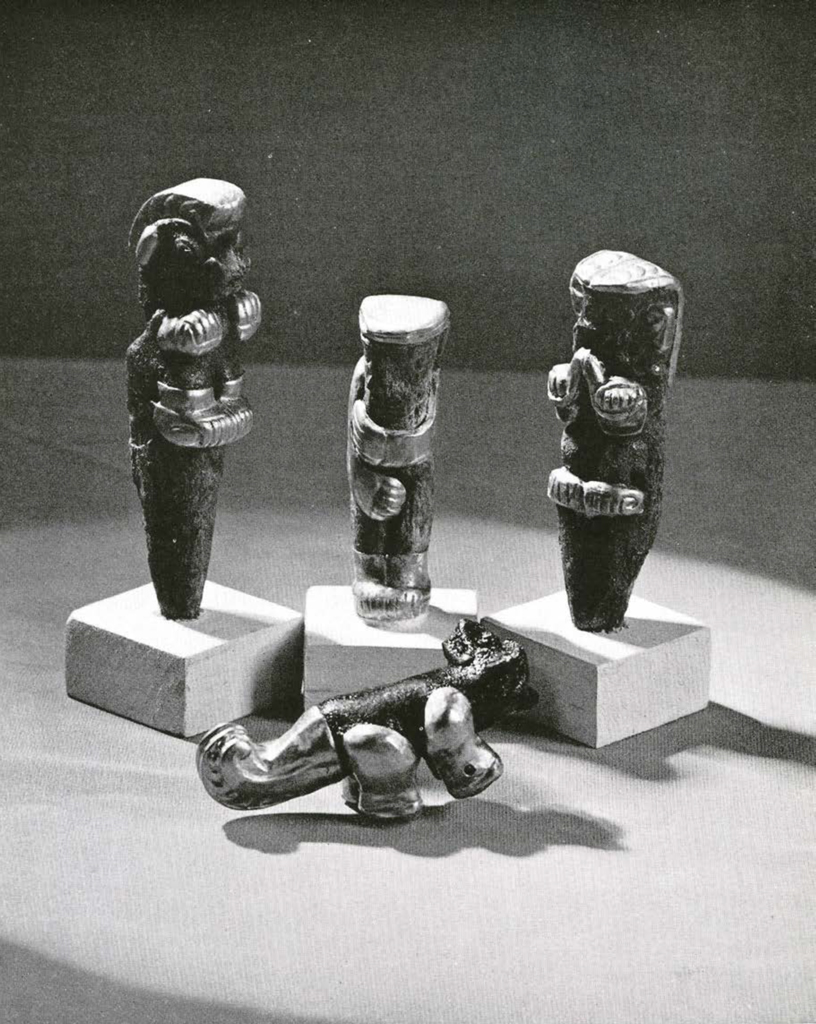
Museum Object Number: 40-13-118 / 40-13-126 / 40-13-119 / 40-13-121 /
Image Number: 19731a, 19731b
Ivory as a material for carving was very rare in ancient America. It is best known from the Eskimo region with its plethora of walrus, narwhal and fossil elephant tusks. Except for the Coclé region ivory carvings are not again known until we reach the coastal regions of Peru. In the present case they were made from the teeth of the lower jaw of the female sperm whale.
Carvings made of resin are even rarer in America. In Europe fossil resin in the form of amber was ever a favorite material for jewelry, but in America amber is so rare as to be practically unknown. Copal resin was a valued material in Central America, particularly among the Mayas and Aztecs who used it as incense in their religious ceremonies. In fact it is employed as incense today in native churches of southern Mexico and Guatemala. Resins from various kinds of trees are used for copal according to the flora of the different regions. Though eminently suited for small carvings it was apparently not much used by native Americans for this purpose. The writer found a few simple ornaments made of copal in the region of Santa Marta in Colombia. In his very detailed report upon the three years’ work of the Peabody Museum of Harvard University at the Sitio Conte in Coclé Dr. S. K. Lothrop does not mention copal; apparently not a piece was found.
Bone, of which the most delicate figurines were made, is a more usual material for carving in America. In Coclé manati ribs and deer vertebrae seem to have been the most common sources.
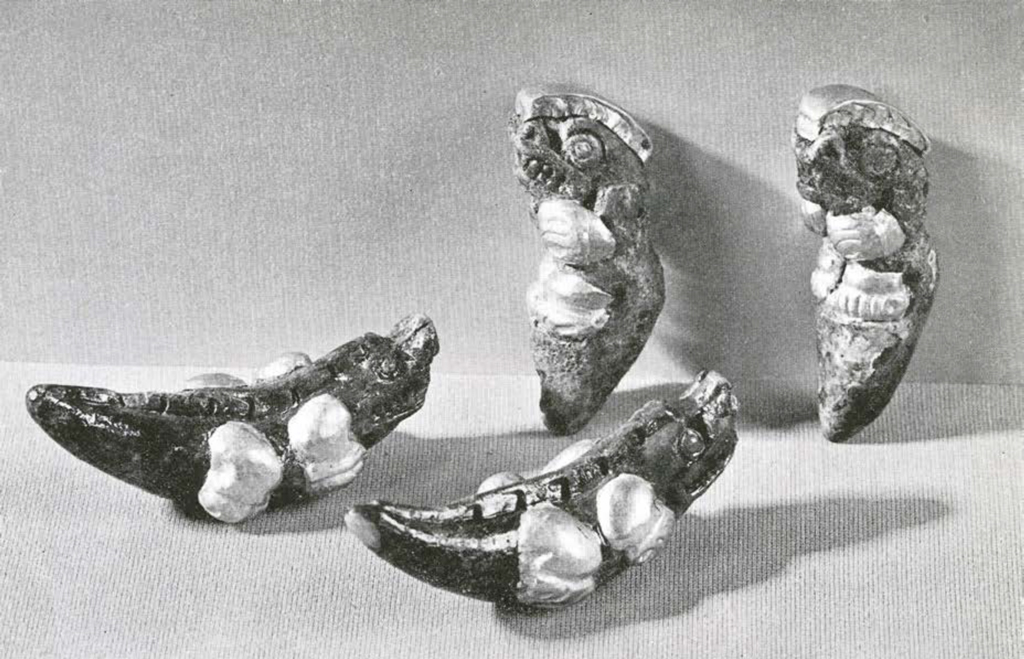
Museum Object Number: 40-13-133 / 40-13-123 / 40-13-122 / 40-13-132
Image Number: 19722
The outstanding characteristic of Coclé figurines, however, is the use of sheaths or onlays of gold. That is to say, arms and legs or feet and hands, wings, tails, eyes, ears, crests or headdresses and similar features are often covered with small pieces of thin gold, beaten to shape with the appropriate details, the ensemble presenting a most attractive appearance. The use of gold sheathing or onlay is known only from Mexico and Peru in addition to Coclé, though sheaths of copper are sometimes found in the mounds of the southeastern United States. Though in the collection of the University Museum gold onlay is found only on objects of ivory, bone and copal, it was also applied to small stone and, rarely, pottery objects. The number of small onlay features found independently, however, suggests that they were also applied to wooden objects that have entirely decayed. The gold was probably panned in the local rivers and made into thin sheets of almost pure metal. So perfectly do they fit the figures that it is probable that they were hammered into form over the details of the carved figure.
Apparently some thirty figures of carved ivory, bone or copal, with or without gold onlay features, were found by the Panama Expedition. The exact number is uncertain as many of them are very fragile and still await restoration. The preservation of any called for the greatest care in excavation, packing, and subsequent treatment. In their deep graves they had been water-soaked, beneath the level of the adjacent river, for probably the major part of each year of the last four centuries and more. When first found, all could have been crushed in the fist to an amorphous mass. They were carefully dug up with the surrounding dirt, packed in cotton, and the overlying dirt removed only after hardening and drying in the Museum. Even with the greatest care many were broken, though some of these may be restorable.
Though always found close to buried skeletons the exact method of use is uncertain. All of them seem to have suspension holes and to have been worn as ornaments on the person of important men. With one exception, all of those well preserved enough to permit study were found in the middle level of the deep rich grave, No. 11, which afforded most of the finest objects found. This grave consisted of three levels containing twenty-three skeletons. Most of the gold ornaments and other beautiful adornments or funerary offerings accompanied the twelve bodies on this middle level, and the majority of them were on one of these twelve, probably that of a great chief. This interment level measured about eight feet in diameter and was at eleven feet from the surface. The twelve bodies were laid parallel and close together in six pairs, each pair consisting of an upper and a lower skeleton. The bones had practically entirely decayed.
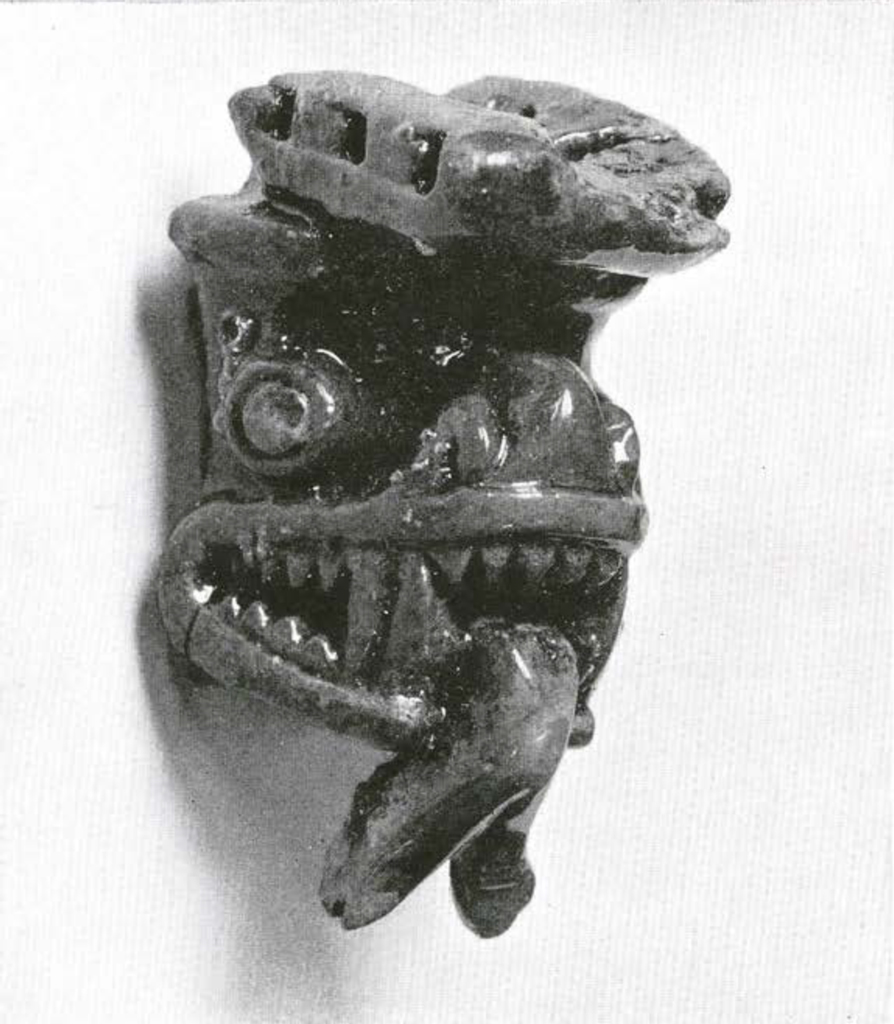
Museum Object Number: 40-13-613
Image Number: 19727
On account of this huddling it was often impossible to tell with which skeleton an object had been placed. Of those specifically noted, five of these figurines accompanied skeleton E, the most richly adorned one, three skeleton L, and three skeleton G. The latter were found at the feet, some of the others on the chests, others haphazard. Often they are found in pairs, almost identical, and the Peabody Museum Expedition frequently found them beneath gold plaques, always in the “richest” graves; they were apparently worn only by men of high social rank.
Of the nineteen figurines in the University Museum which are sufficiently intact or restored to merit note here, seven are of copal resin and twelve of ivory or bone. Two of the copal figurines and eight of the ivory ones are decorated with gold onlay features, but several of the others may once have had this application. The life-forms represented vary from very naturalistic to quite conventionalized, and from purely animal to purely human, including anthropomorphic animals, probably deities. Birds, crocodiles, quadrupeds and fish are represented. One very common form is not naturalistic but a complete whale tooth with a gold ferrule cap, like a gold-headed dagger.
IVORY AND BONE FIGURINES
MOST of these seem to be of ivory. Probably of bone are the two of most delicate workmanship, unfortunately both consisting merely of heads. Probably both had bodies of human shape and represent anthropomorphic deities. The larger and more complete one (Plate VI) has human eyes and general shape, but the nose is enlarged and the mouth animal-like with large canines and many small sharp teeth. The latter features may be those of a bat, an animal very important in the theology of the Isthmian region. The ear-ornaments and the crest or headdress falling down the neck are ornate. The fragmentary face (Plate V) is more animal-like in every respect, with larger and more protruding nose and mouth, and eyes at the side of the head. The tongue is forked like a snake’s, and it is probable that some draconic deity of the aboriginal mythology is represented. The crest overhangs the forehead. The delicate nature of the carving may be judged from the fact that this face is only one inch in total height; the larger head is but little more.
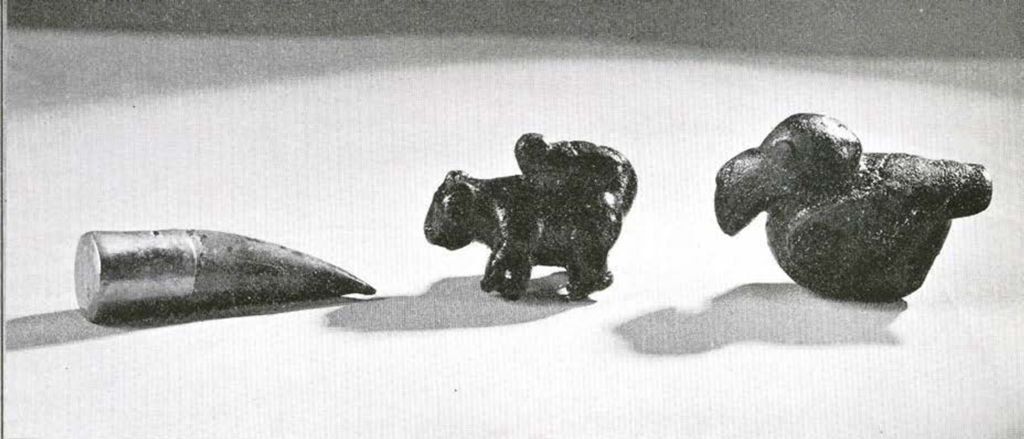
Museum Object Numbers: 40-13-604 / 40-13-605
Image Number: 19750a
The source of the ivory employed is shown by the fact that most of the figurines taper towards the base, the point of the whale tooth. The human figure (Plate IV) is about three inches high. As usual in primitive art the head is disproportionately large, the legs equally short. He leans forward and is either slightly hump-backed or else carries a pack on his back. The legs are separated by a groove but there are no other carved details except the simple facial ones; unfortunately the nose has been injured. The feet are encased in a single gold sheath with toes indicated, and fingers and hair are represented by grooves in the arm and crest gold onlays. The asymmetric position of the two arms is quite unusual for American primitive art.
Two anthropomorphic figures are shown seated but the tapering ends extend below the feet like tenons. The bodies are rudely shown and of disproportionately small size but apparently human. In both, the feet, with impressed details showing the toes, are covered by a single gold onlay. In one (Plate IV, left) the hands with the fingers indicated are of two onlays; in the other (Plate IV, right) they coalesce in one, and the fingers, or something held in the hands, are raised to the mouth. The heads are quite different but both have gold onlay crests and ears, most of them decorated with some detail. The larger one had two gold eyes, one of which remains. The details of both faces are imperfectly preserved. One is like the larger head (Plate VI) with human form and eyes, but with traces of the projecting jaw with large canines and many sharp smaller teeth; the other is like the smaller fragmentary head (Plate V), much more zoomorphic with eyes at the side of the face and very projecting snout. These are three and one half, and four and one quarter inches high.
A pair of figurines about two inches long (Plate V) are made of small whale teeth with the lower ends pointed and are almost identical. With seated human bodies and animal heads they probably represent the crocodile god. The gold onlay hands are separate while the feet are in one piece. The fingers and toes are modified into claws; both have gold crests. The heads are distinctly not human, with very projecting snout and eyes on the same level.

Museum Object Number: 40-13-612
Image Number: 19728
Quite naturalistic are a pair of ivory crocodiles (Plate V), two and one half inches long. The natural pointed end of the whale tooth forms the animal’s tail. They are very convex with heads and tails in the air, a rather natural posture. The heads are naturalistically carved and the mouths open with a round orifice as if for the insertion of another object. A ridge with crescentic holes represents the vertebrae, and the four feet are provided with separate gold onlays with the claws represented.
In Plate VI is shown one of a number of uncarved whale teeth with geld ferrule end, three inches long. These were probably also worn as pendent ornaments.
A pair of small flat fish (?), two and one half inches long (Tailpiece, Page 21), completes the list of intact ivory figurines. No fins are represented; the short body tapers to a pointed tail. The heads are large and considerably stylized with large flat mouths full of small sharp teeth.
FIGURINES OF COPAL RESIN
THE seven figures of copal resin are all of animals and all naturalistic; there is little of the conventionalization of some of the ivory figurines. It is likely that these were purely ornamental while the ivory ones had a mythological or religious significance. Possibly they were modeled or even cast in a mold while the gum was still soft. The surfaces of these have suffered more from the constant dampness than the ivory figurines, and such details of technique cannot now be determined.

Museum Object Number: 40-14-636
Image Number: 19748
The most attractive specimen is a small quadruped with a very large tail (Plate IV), three inches long. The head is turned so far to the side that the animal looks upward. Such asymmetry is unusual and shows a high art development. The four feet and the large upcurved tail are encased in gold sheaths in which details such as claws are represented. The only other copal figurine with gold onlay apparently represents a bird, though the surface has weathered so much that few details are discernible. The sheathing representing wings and two feet, each of the latter with four long claws, is all in one piece.
The largest of the copal figurines also represents a bird (Plate VI). This is fat, nearly three inches long, two high, and one and one half thick. The body is naturalistic though feet are wanting, but the head with large curved beak is disproportionately large. Possibly the most naturalistic of all the figurines (Plate VI) represents a quadruped with a large tail curving over the back; this distinctive characteristic indicates that a squirrel was intended.
The smallest of all the figurines, little more than one and one half inches long is a little quadruped with its fat belly hanging below its short legs, and a disproportionately large head with long nose. Large canines and many small sharp teeth are shown. An elongated figurine (Plate VI) has the present appearance of a sea-horse with large head and large, long, curved tail. Three of the legs are missing but the fourth shows that they were very short; the surface is much eroded and many of the details gone, but the head was originally well carved. A quadruped animal of some type was obviously portrayed.
The only figurine not found in Grave 11 came from Grave 15. This (Plate VI) is very elongated, three and one half inches long. The style of art is a little different from the others. It probably represents a crocodile, a very common art motive, but is not so naturalistic as the others. The body is fat, the head short with the mouth open. The short legs, instead of being carved in the round, are shown in low relief against the body. The general shape, the tail tapering to a point, suggests that it may have been formed with a whale-tooth ivory carving as its prototype.
J. A. M.
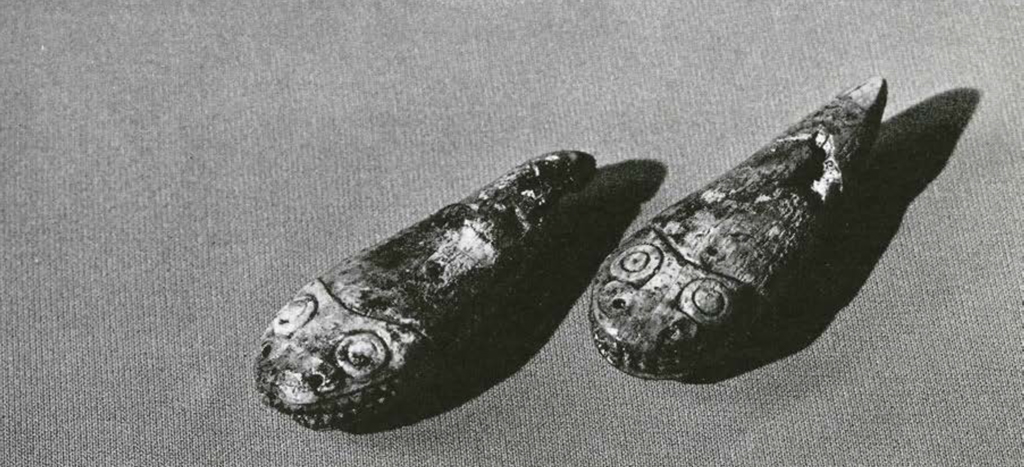
Museum Object Numbers: 40-13-614 / 40-13-615
Image Number: 19721

